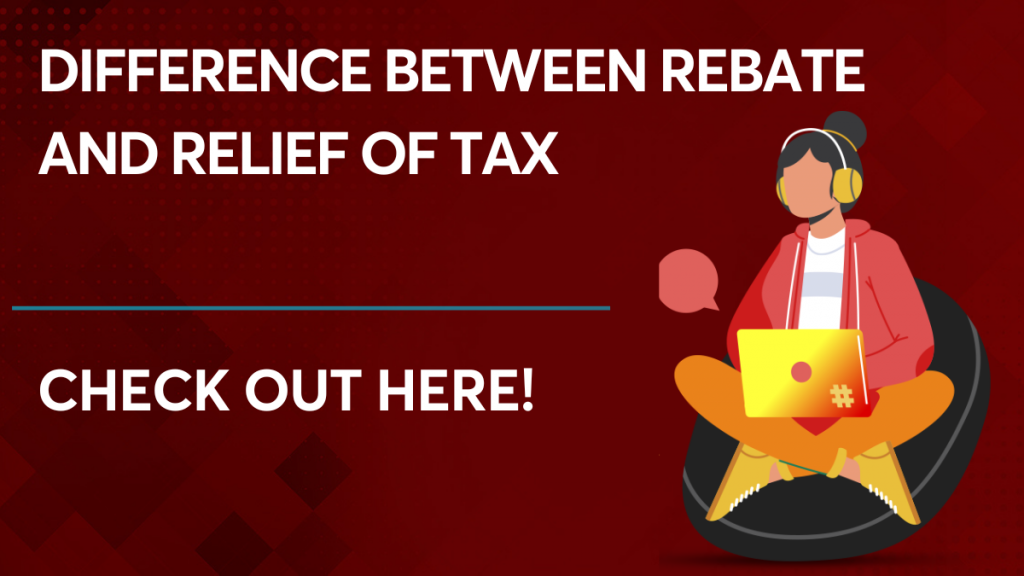Last updated on February 14th, 2023 at 02:12 pm
For most people, taxes are a necessary evil. It’s important for citizens to pay their fair share of taxes, but it can be hard to make sense of all the different types of taxes and their associated definitions. One of the most common tax terms is the Difference Between Rebate And Relief of Tax, yet many people don’t understand what it means or how it affects them. In this blog post, we’ll take a look at the Explain Rebate And Relief of Tax so you can better understand what each term entails and how they impact your finances. So, read on to learn more about the Difference Between Tax Relief And Tax Rebate!
What is a rebate?
If your taxes paid exceed your tax due, you may be entitled for a tax rebate. For instance, if the bank pays the government a TDS of Rs. 30,000 on your behalf while your tax burden is Rs. 20,000, you are entitled to a tax refund.
In other words, if your tax due is lower than the amount you paid in taxes, you will receive a refund at the end of each financial year. If you want to get the income tax refund, you must submit an income tax rebate within a certain time frame.
What is the relief of tax?
When it comes to taxes, the word “relief” can have a few different meanings. In general, tax relief is any reduction in the amount of taxes you owe. This could be in the form of a tax credit, which reduces your taxes owed dollar-for-dollar, or a tax deduction, which lowers your taxable income.
There are also a few specific types of tax relief that businesses or individuals may be eligible for. For example, the earned income tax credit (EITC) is a refundable credit available to low- and moderate-income taxpayers. And if you’ve been affected by a natural disaster, you may be able to get relief from certain deadlines and penalties related to your taxes.
If you’re looking for ways to reduce your taxes owed, talk to a tax professional about what relief options may be available to you.
Difference between Rebate and Relief of Tax
The Difference Between Exemption Deduction And Rebate of Tax are given below the Table:
| Rebate Tax | Relief Tax |
|---|---|
| Tax rebate is a refund of tax that has already been paid | The relief of tax is a reduction in the amount of tax that is payable. |
| Tax rebate is available to taxpayers who have overpaid their taxes | The relief of tax is available to taxpayers who are unable to pay their taxes in full. |
| A rebate must be claimed by the taxpayer | relief of tax does not have to be claimed and is automatically applied. |
| A rebate can be issued for both federal and state taxes | relief of tax is typically only given for federal taxes. |
| Rebates are usually given as a lump sum payment | The relief of tax is typically given as a reduction in the amount owed. |
| Rebates can be issued for any amount of overpayment | The relief of tax is typically only given for small amounts. |
| Rebates can be used to offset future taxes owed | The relief of tax cannot be used to offset future taxes owed. |
| Rebates can be issued for any type of tax | The relief of tax is typically only given for income taxes. |
| Rebates can be issued at any time | relief of tax is typically only given during filing season. |
| Taxpayers can receive multiple rebates in a year | relief can only receive one relief of tax per year. |
Difference Between Rebate And Relief Of Tax: 5 FAQs
A rebate is a refund of tax that has been paid on something, typically given back as money. Tax relief, on the other hand, is a reduction in the amount of tax that you owe.
Rebates are typically given out when you’ve overpaid on taxes or made certain qualifying purchases. For example, if you’ve overpaid your taxes for the year, you may be eligible for a rebate. Similarly, if you’ve made energy-efficient improvements to your home, you may be eligible for a rebate from your utility company.
The process for claiming a rebate will vary depending on the situation. However, generally speaking, you’ll need to fill out a form and submit it along with any supporting documentation to the organization offering the rebate.
There are many different types of tax relief, but some common examples include deductions, credits, and exemptions. Deductions lower your taxable income, while credits lower your tax liability dollar-for-dollar. Exemptions exempt certain types of income from taxation altogether.
To find out if you’re eligible for any rebates or relief of tax, you’ll need to contact your local tax authority. They will be able to tell you what rebates or relief of tax you may be eligible for and how to claim them.
